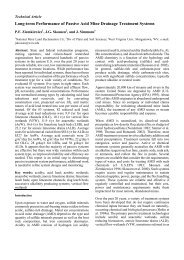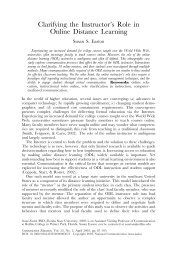Small Hydroelectric Plants - West Virginia University
Small Hydroelectric Plants - West Virginia University
Small Hydroelectric Plants - West Virginia University
You also want an ePaper? Increase the reach of your titles
YUMPU automatically turns print PDFs into web optimized ePapers that Google loves.
For generations water has been used as a source of<br />
energy by industry and by a limited number of utility<br />
companies. In the continental United States, most<br />
rivers and streams capable of producing huge<br />
amounts of hydroelectric power have been harnessed;<br />
however, this does not preclude the possibility of<br />
using mini-hydroelectric power as a source of energy<br />
supply for home or farm.<br />
Harnessing a stream for hydroelectric power is a<br />
major undertaking. Careful planning is necessary if a<br />
successful and economical power plant is to result.<br />
State water laws and environmental concerns must be<br />
determined. Precise field data must be gathered to<br />
compare the amount of power that can be expected<br />
from a hydroelectric installation to the electrical<br />
requirements of the home or farm. Then detailed plans<br />
that consider both construction and maintenance can<br />
be drawn up.<br />
Perhaps the greatest mistake made when considering<br />
small hydroelectric installations is the overestimation<br />
of a proposed plant’s capability. This bulletin will<br />
help you start the planning of a small power plant on a<br />
given stream of water. One of the first steps in<br />
planning is to measure the power potential of the<br />
stream. The amount of power that can be obtained<br />
from a stream depends on:<br />
- the amount of water flow<br />
- the height which the water falls (head)<br />
- the efficiency of the plant to convert mechanical<br />
energy to electrical energy.<br />
State water laws and environmental concerns must be<br />
determined.<br />
<strong>Small</strong><br />
<strong>Hydroelectric</strong><br />
<strong>Plants</strong><br />
EPP-13.ON<br />
FS 13<br />
Harnessing a stream for hydroelectric power is a<br />
major undertaking.<br />
Stream Flow<br />
Stream flow varies greatly from season to season and<br />
depending on the nature of the terrain. A typical<br />
discharge from a 22 square mile hilly to mountainous<br />
drainage area in the Northeast during a year of<br />
normal precipitation is summarized as:<br />
Maximum<br />
Discharge<br />
Minimum<br />
Discharge<br />
Average Daily<br />
Discharge<br />
Median<br />
Discharge l<br />
0.6 cfs<br />
25.2 cfs<br />
8.4 cfs<br />
502 cfs<br />
WATER FLOW, Cubic Feet per Second (cfs)²<br />
1<br />
F1ow is 8.4 cfs or less for 183 days or ha1f the year.<br />
2<br />
1 cubic foot per second = 449 gallons per minute.<br />
The smallest commercially manufactured hydroelectric<br />
power plant at one-half kilowatt (KW) or 500<br />
watts needs 1.1 cfs with a 12’ height of water fall or<br />
head. Therefore no power can be generated during<br />
low-flow periods without reservoir storage. It is also<br />
interesting to look at the peak flow. A ten-kilowatt<br />
hydroelectric plant needs 16.3 cfs with a 12´ head,<br />
leaving a substantial part of the peak flow to be<br />
contended with—not a simple task. This extreme<br />
variation illustrates the value of a reservoir to<br />
regulate and even the flow.
Measuring Flow<br />
Two methods are commonly suggested for measuring<br />
the flow in small or medium sized streams. Large<br />
discharges are best determined by a hydraulic<br />
engineer. The float method of testing stream flow is<br />
the easiest test to conduct and will yield satisfactory<br />
data, except in cases where a stream is shallow or<br />
rocky and thus impedes the movements of a weighted<br />
float.<br />
Basically the cross section of an unobstructed area of<br />
the stream is measured and a weighted float such as a<br />
bottle weighted with pebbles is timed as it floats down<br />
a 100 foot course.<br />
The weir method is more time consuming but may be<br />
the most satisfactory test if the stream is very small,<br />
shallow, rocky, obstructed, or if there is an existing<br />
dam. A weir is a dam with an opening or notch through<br />
which the entire stream flows. The flow may be<br />
calculated by precisely measuring the depth of water<br />
flowing over the crest of the weir. Tongue and groove<br />
planking makes a good temporary weir for streams not<br />
more than one or two feet deep and six to ten feet wide.<br />
Stream flow varies greatly from season to season;<br />
thus field data must be gathered many times throughout<br />
the year.<br />
The selected references give more detail on how to<br />
measure stream flow by the weir or float method. No<br />
matter what method of flow measurement is used, it is<br />
very important to measure stream flow many times<br />
over a year or more.<br />
MEASURING FLOW with a FLOAT<br />
STEP 1: MEASURING<br />
CROSS-SECTON AREA<br />
Measure depth at one foot intervals<br />
Average Depth =<br />
STEP 2: MEASURING<br />
WATER VELOCITY<br />
Water Surface<br />
Sum of measured depths<br />
# intervals measured<br />
STEP 3: CALCULATING FLOW RATE<br />
The flow rate is calculated by the formula:<br />
Q = flow rate, cubic feet per second<br />
b = stream width, inches<br />
d = average stream depth, inches<br />
t = time for float to drift 100 feet, seconds
Dams<br />
Water must fall in order to generate power from a<br />
stream. In most cases the fall is enhanced and<br />
increased by constructing a dam which creates a head.<br />
(The head is the vertical distance from the surface of<br />
the water at the dam down to the water in the stream<br />
below where the turbine is located.) The higher the<br />
dam or head, the greater the power a given amount of<br />
water will produce. A dam also provides a storage<br />
basin to regulate stream flow and thereby increases<br />
power potential.<br />
Before pursuing dam construction further, you should<br />
consider these points:<br />
1. The construction of a dam is a highly<br />
technical undertaking. You need to collect extensive<br />
field data to choose the best site and design a<br />
safe dam. A professional engineer can best<br />
advise you on construction of a safe dam for your<br />
particular site.<br />
2. Find out what permits are required if a<br />
stream is to be impounded. Laws vary from state<br />
to state: some are lenient; some are very<br />
stringent. Your state environmental conservation<br />
office should be able to supply you with the<br />
necessary information.<br />
3. Be aware that you must control all land to be<br />
flooded.<br />
4. In the event of dam failure, you will be<br />
responsible for all downstream damage. Your<br />
insurance underwriter may be able to advise you<br />
on the availability of liability insurance.<br />
5. You must respect the rights of others to<br />
stream use outside of your property.<br />
6. You may be faced with resistance from<br />
nearby landowners and conservation-minded<br />
groups or individuals.<br />
7. Obtain solid cost estimates for the dam<br />
construction. Costs vary widely, depending on<br />
the particular site, but it is reasonable to assume<br />
that the construction of any worthwhile dam will<br />
run to several thousand dollars. Will the capital<br />
outlay for construction be justified by the longterm<br />
benefits of an installation?<br />
Diversions<br />
Because legal requirements and high costs restrict<br />
new dam construction, other methods of water<br />
development may be more suitable. In some places<br />
only a round concrete box structure is needed to divert<br />
part of the flow of a stream through a pipe to a<br />
downstream turbine.<br />
On any given stream, the best site for a diversion is<br />
usually quite obvious: a natural waterfall, a swift<br />
current or a steep slope. The terrain should be steep<br />
enough (10% slope or more) so the diversion pipe<br />
doesn’t have to be too long to obtain sufficient head.<br />
Because a diversion has no backup storage for periods<br />
of low flow, potential power is sometimes calculated<br />
by determining the runoff in a year of normal rainfall<br />
which is exceeded on half the days of the year. The<br />
example watershed (page 1) has a stream flow of 8.4<br />
cubic feet per second or less for half the year. With a<br />
12' head, this stream can operate a 5 KW generator at<br />
full capacity for half the year and at about 50%<br />
capacity for the remainder. Some people install<br />
batteries to provide electrical storage for periods of<br />
low flow.
Measuring Head<br />
After the height of the water behind the proposed dam<br />
or diversion has been decided, it is necessary to<br />
measure the head of water that will result. To<br />
determine the difference in level between two points,<br />
set a surveyor’s level about midway between the<br />
points. Have an assistant hold a surveyor’s rod at one<br />
point, sight through the level and record the height<br />
reading on the rod. Move the rod to the second point<br />
and read. The difference of the readings is the<br />
difference in elevation of the two points.<br />
Often it is impossible to see the two points from a<br />
single setting of the level so rods must be read at<br />
intermediate or turning points. The differences in<br />
readings between each pair of points can be added<br />
together to calculate the total elevation drop from the<br />
dam or diversion.<br />
HEAD =h 2 + h3 - h1<br />
MEASURING the HEAD<br />
Calculating Power<br />
Power output, in kilowatts is calculated by the<br />
formula:<br />
KW = 0.0846 x E x Q x H<br />
where: Q =<br />
H=<br />
E=<br />
water flow, cubic feet per second<br />
head, feet<br />
efficiency of hydroelectric plant, percent<br />
divided by 100.<br />
Friction, generator losses and turbine losses reduce<br />
the efficiency of a power plant. <strong>Small</strong> plants are about<br />
40% efficient. Five to ten kilowatt plants may be 60 to<br />
70% efficient when operating at full capacity. For<br />
initial estimates, calculate power based on 50%<br />
efficiency.<br />
Table 1 lists the water flow and head needed to run<br />
various small hydroelectric plants operating at 50%<br />
efficiency. Manufacturers of hydroelectric plants also<br />
list power outputs of their units at various flows and<br />
heads.<br />
Table 1. Required water flow and head for small<br />
hydroelectric plants.<br />
Generator<br />
output,<br />
Kilowatts 1<br />
0.5<br />
1<br />
2<br />
5<br />
10<br />
HEAD, feet<br />
10' 20' 50' 100' 200'<br />
WATER FLOW, Cubic Feet per Second<br />
1.2 0.6 0.24 0.12 0.06<br />
2.4 1.2 0.5 0.24 0.12<br />
4.7 2.4 0.9 0.5 0.24<br />
11.8 5.9 2.4 1.2 0.6<br />
23.6 11.8 4.7 2.4 1.2<br />
1<br />
Overall hydroelectric plant efficiency is 50%<br />
Components<br />
Penstocks<br />
Friction in the pipe (penstock) or open channel that<br />
carries water to the generator is another cause of<br />
power loss. Most small hydroelectric sites have a<br />
small or moderate head, so it is very important to use<br />
large penstocks to reduce losses.<br />
If you are diverting a water source far up the hill,<br />
plastic or aluminum irrigation pipe and the heavier<br />
walled, pressure rated PVC plastic pipe make good<br />
penstocks. Table 2 shows head losses for typical<br />
plastic pipe. The flow rates to the right of the dashed<br />
lines have velocities that exceed 5 to 7 feet per second<br />
and are not recommended. Use a larger pipe instead.
Table 2. Head loss for plastic pipe<br />
Nominal<br />
Pipe Inside<br />
Flow Rate, cubic feet per second 1<br />
Diameter, Diameter, 0.1 0.2 0.3 0.4 0.6 0.8 1.0 2.0 4.0 6.0 8.0 10.0<br />
Head Loss, feet per 100 feet of pipe<br />
160# PVC Plastic Pipe<br />
Flow rates to the right<br />
2" 2.193" 2.44 8.22 18.7<br />
of the vertical lines have<br />
3" 3.230" 0.37 1.34 2.84 4.83 10.2<br />
velocities over 7 feet<br />
per second and are not<br />
4" 4.154" 0.11 0.39 0.83 1.42 3.01 5.12 7.74<br />
recommended.<br />
80 psi Plastic Irrigation Pipe<br />
6" 5.900" 0.07 0.15 0.26 0.54<br />
8" 7.840" 0.06 0.14<br />
10" 9.800"<br />
12" 11.760"<br />
1<br />
1 cubic foot per second = 449 gallons per minute<br />
For example, Table l shows a 2KW generator requires<br />
0.6 cfs with a l00 foot head. Three hundred feet of 3"<br />
PVC pipe carrying 0.6 cfs from an upstream diversion<br />
has a head loss of 3 x 10.2 = 30.6 feet. Thus the<br />
diversion must be 100 + 30.6 = 130.6 feet above the<br />
generator to compensate for the friction or head loss in<br />
the pipe. A 6" pipe has only a 0.54 x 3 = 1.62 foot head<br />
loss.<br />
Trash Racks and Head Gates<br />
Even small streams can become torrents carrying<br />
large trees and other debris. Plan to protect the<br />
generator and water passages from debris by installing<br />
a trash rack at the head of the penstock. Set steel<br />
bars on edge to the flow of water and space about 1"<br />
apart. Normally trash racks are set on an incline to<br />
increase area so water velocity is less than 1.5 feet per<br />
second through the rack. An inclined rack is easier to<br />
clean with a rake. This feature is particularly<br />
important in the fall because leaves may blanket a<br />
rack in an hour or two.<br />
A head gate or valve should be installed below the<br />
trash rack to control flow and to allow the turbine to<br />
be inspected and repaired.<br />
Turbines<br />
The towering water wheel driving the old mill’s<br />
grinding stones creates a romantic image, but it is too<br />
slow and ponderous to efficiently convert water<br />
power to electric power. For example, a 5 foot diameter<br />
0. 93 1.40 5.06<br />
0.23 0. 35 1.27 4.58 9.70<br />
0.08 0.12 0.43 1.54 3.27 5.58 8.42<br />
0.05 0.18 0. 64 1.35 2.29 3.47<br />
wheel that is 16" wide will generate only 300 watts or<br />
less. A compact turbine and generator is a better<br />
choice unless you are renovating an old mill site.<br />
<strong>Hydroelectric</strong> plants are available in capacities<br />
ranging from 1/2 KW to 12 KW.<br />
A reaction turbine, either the Francis type or propeller<br />
wheel type, is turned by a mass of water falling<br />
through a duct encasing a wheel. Reaction-type<br />
generators are good choices if you have ample water<br />
supply but a low head. A reaction wheel is subject to<br />
greater friction losses than an impulse wheel; however,<br />
it has greater flexibility in installation.<br />
Penstock<br />
REACTION TURBINE<br />
An impulse (Pelton) turbine turns by the velocity of a<br />
jet of water striking the turbine’s wheel cups and can<br />
operate on as little as 1.5 cfm of water. In order to be<br />
most effective, a head of at least 50’ is required.
IMPULSE TURBINE<br />
The type of facility you wish to provide with electrical<br />
service will largely determine whether you use an<br />
Alternating or Direct-Current generator. Lights and<br />
the universal motors that operate small appliances<br />
and tools will operate on DC. Larger motors, TV’s and<br />
many appliances require AC to operate. Alternating<br />
Current may be transmitted greater distances and on<br />
smaller wires than is possible with Direct Current;<br />
however, an AC installation does require an extra<br />
investment in governing equipment.<br />
Direct Current generators are usually less expensive<br />
than AC generators but they do require expensive<br />
inverters to convert to AC. The potential of storing DC<br />
in batteries during low-usage periods and at times of<br />
uneven water flow is a compensation of such a system.<br />
Causes of Failure<br />
The main reasons for lack of success with small<br />
water power developments are:<br />
Selected References<br />
Design of <strong>Small</strong> Dams. U.S. Department of Interior. Supt. of<br />
Documents, U. S. Government Printing Office, Washington<br />
DC 20402<br />
Ponds for Water Supply and Recreation. Agric. Handbook<br />
No. 387. Soil Conservation Service, USDA<br />
“Your Own Water Power Plant”, Popular Science, 1947.<br />
Reprinted in issues no. 13 and 14 Mother Earth News.<br />
“Water Power for Your Home”, Popular Science, May 1977<br />
1.<br />
2.<br />
3.<br />
4.<br />
5.<br />
6.<br />
7.<br />
Failure to realize how important full field data<br />
is for proper design.<br />
Failure of homemade equipment made with<br />
junked parts.<br />
Over-estimating the amount and constancy of<br />
the stream flow.<br />
Penstocks or flumes that are too small to allow<br />
the plant to operate at full capacity.<br />
Failure to anticipate the expense of keeping<br />
trash racks clear and machinery in good<br />
repair.<br />
Failure to design and plan for winter ice<br />
buildup.<br />
Overestimation of a proposed plant’s capability.<br />
The average home has demand peaks<br />
varying from 4 to 12 kilowatts.<br />
The Northeast Regional Agricultural Engineering Service is an activity of the Cooperative Extension Services of<br />
the Northeast Land Grant Universities and the United States Department of Agriculture.<br />
<strong>University</strong> of Connecticut Ž <strong>University</strong> of Delaware Ž <strong>University</strong> of Maine Ž <strong>University</strong> of Maryland<br />
<strong>University</strong> of Massachusetts Ž <strong>University</strong> of New Hampshire Rutgers <strong>University</strong> Ž Cornell <strong>University</strong><br />
Pennsylvania State <strong>University</strong> Ž <strong>University</strong> of Rhode Island Ž <strong>University</strong> of Vermont <strong>West</strong> <strong>Virginia</strong> <strong>University</strong><br />
Headquarters are located at Riley-Robb Hall, Cornell <strong>University</strong>, Ithaca, N.Y. 14853<br />
Cooperative Extension Provides Equal Program and Employment Opportunities<br />
FS-13<br />
Nov ’78 10M<br />
I










